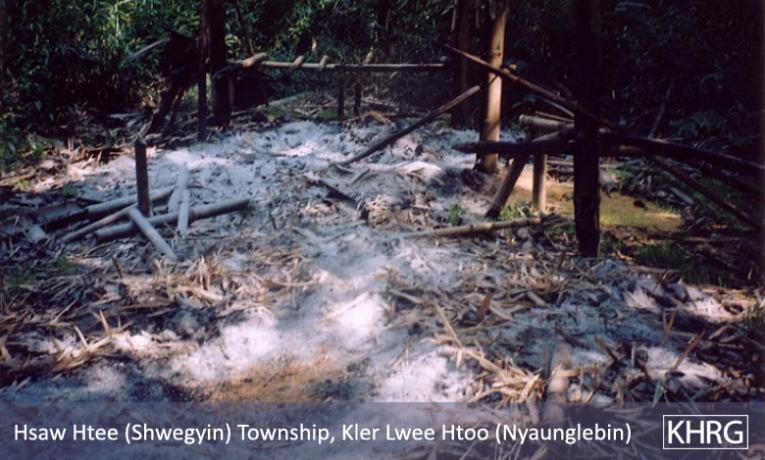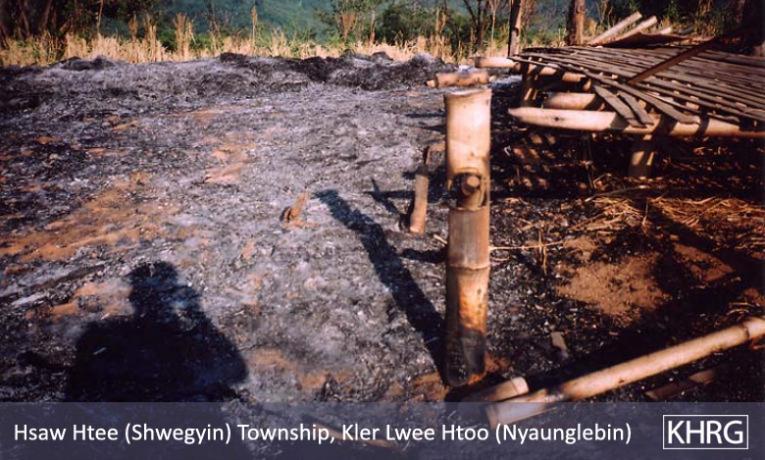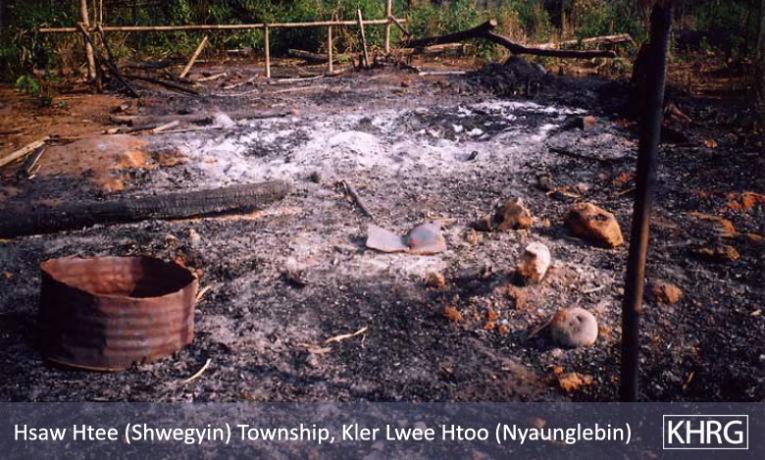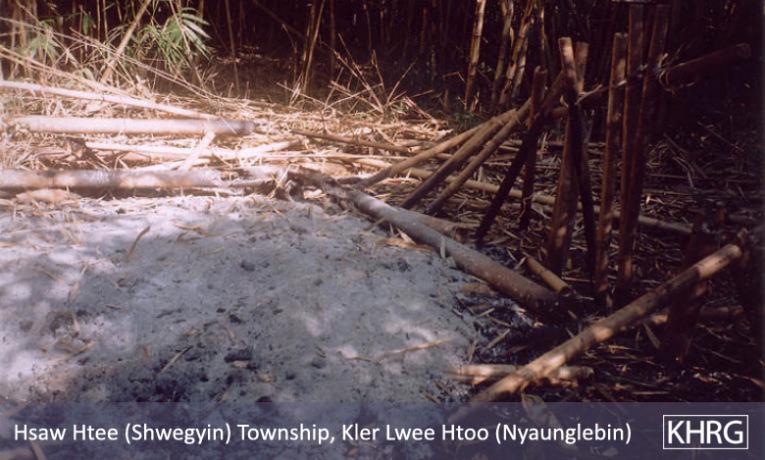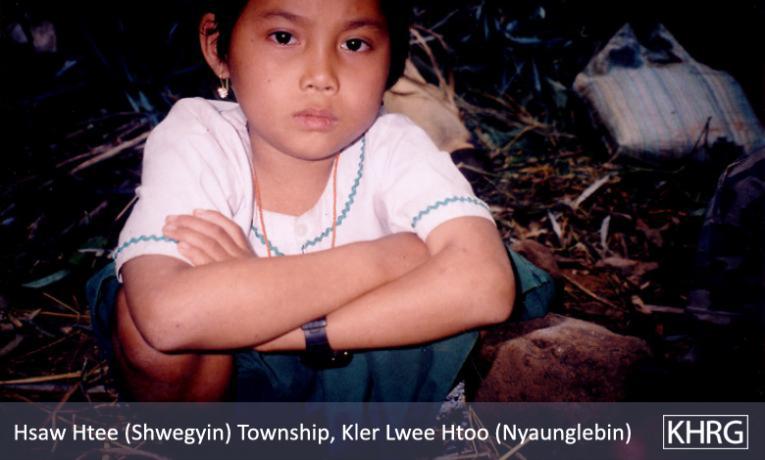The photos below were taken between mid-November and mid-December 2004, and tell the story of how the people of a few villages in the Yah Aw area of eastern Shwegyin township (see map) responded. Rather than surrender to SPDC control, they fled into the forest. What followed, however, was not panic and starvation, but a systematic effort to re-establish food security and other aspects of their lives and communities. Within a few days shelters were built, lookouts posted, and makeshift schools and worship services were going on, while people continued covertly returning to retrieve food supplies and complete their harvest, all in dangerous conditions and with no outside help whatever. People's efforts focused not merely on physical survival, but on continuing life with dignity and community cohesion. They had been through this before, most of them several times. From October 2004 through January 2005, SPDC forces based in the plains of western Nyaunglebin district made forays eastward up the rivers into the hills in an effort to flush out the hill villagers who have thus far evaded their control. The timing deliberately coincided with the annual rice harvest, and the tactics were simple: seek out the villagers' fields, burn or scatter the harvested grain, destroy the crop still in the fields by trampling or landmining it, or let animals and insects destroy it once the villagers have fled. Burn the rice storage barns, the houses, schools and churches, and shoot the villagers on sight. Make life in the hills untenable, so that villagers have to come and live under SPDC control.
From October 2004 through January 2005, SPDC forces based in the plains of western Nyaunglebin district made forays eastward up the rivers into the hills in an effort to flush out the hill villagers who have thus far evaded their control. The timing deliberately coincided with the annual rice harvest, and the tactics were simple: seek out the villagers' fields, burn or scatter the harvested grain, destroy the crop still in the fields by trampling or landmining it, or let animals and insects destroy it once the villagers have fled. Burn the rice storage barns, the houses, schools and churches, and shoot the villagers on sight. Make life in the hills untenable, so that villagers have to come and live under SPDC control.
The photos below were taken between mid-November and mid-December 2004, and tell the story of how the people of a few villages in the Yah Aw area of eastern Shwegyin township (see map) responded. Rather than surrender to SPDC control, they fled into the forest. What followed, however, was not panic and starvation, but a systematic effort to re-establish food security and other aspects of their lives and communities. Within a few days shelters were built, lookouts posted, and makeshift schools and worship services were going on, while people continued covertly returning to retrieve food supplies and complete their harvest, all in dangerous conditions and with no outside help whatever. People's efforts focused not merely on physical survival, but on continuing life with dignity and community cohesion. They had been through this before, most of them several times.
Unlike other sections of this photo set which show the most recent photos first, this section follows the progress of the SPDC troops and the people of several villages from mid-November through mid-December 2004. Since then they have worked to re-establish their villages, but without staying in them due to the fear of renewed SPDC attacks. Most are now facing food shortages and uncertainty about the coming planting season, without knowing whether SPDC forces will repeat the operation when the next harvest is due in late 2005. Regardless, they are determined to remain on their land and beyond SPDC control. For additional information, see Nyaunglebin District: Food supplies destroyed, villagers forcibly displaced, and region-wide forced labour as SPDC forces seek control over civilians (KHRG #2005-F4, 4/5/05).
Photos #1-1, 1-2, 1-3:On November 18th 2004, a column from SPDC LIB #589 burned houses and rice supplies in Klaw Lu village, near Yah Aw (Yan Aung), Nyaunglebin district, in the hills east of Shwegyin town. These photos were taken the following day. The square of ash in photo 1-1 used to be the house of the villager in the photo; he had returned to see if anything could be salvaged. Photo 1-2 shows all that remains of another house. Photo 1-3 shows part of a villager's stored supply of paddy for the year, dumped on the ground and burned. [Photos: KHRG researcher]
Photo #1-4: On November 19 th 2004 a KHRG researcher encountered Saw P---, age 75, along a path in the forest in Shwegyin (Hsaw Tee) township, Nyaunglebin district. He said he was searching for his family because when an SPDC Army column approached their village they fled and became separated. Families usually flee approaching columns in this region because SPDC troops usually detain villagers as porters or suspected rebels, so family separation is often a problem. [Photo: KHRG researcher]
Photos #1-5, 1-6: When LIB #589 came into the Yah Aw area of Shwegyin township and burned Klaw Lu village (see photos 1-1 through 1-3), everyone in Klaw Lu, K'Hee Day and Khaw Hta villages fled into the forest. Two days later on November 20 th 2004, these photos show some of them after returning to their villages to retrieve some of their rice supplies so they can survive in the forest. [Photos: KHRG researcher]
Photos #1-7, 1-8, 1-9, 1-10, 1-11, 1-12: Several days after the burning of Klaw Lu village (see above), the SPDC column was still in the area so the villagers remained hidden, cooking rice only at night so smoke from cookfires would not give them away. Photos 1-7 and 1-8 show some of the children settling in for the night. Photo 1-9 shows 60-year-old Pi K--- and her husband. They have no children and were unable to carry rice themselves while fleeing, so they had no food and had to share that of others. In photo 1-10, a Christian pastor who was visiting the area when the villages were invaded gathers the Christian villagers in the forest for a worship service. Naw P---, 46 ( photo 1-11), fell sick in the forest and was cared for by other villagers. Naw D---, age 75 ( photo 1-12), is blind; when the villagers fled one of her sons (shown here) carried her while the other carried food. All of these photos were taken on November 20 th and 21 st 2004, within three days of the arrival of the SPDC column in the area. [Photos: KHRG researcher]
Photos #1-13, 1-14, 1-15, 1-16: By November 21 st 2004, three days after SPDC LIB #589 had entered the area, the villagers from Klaw Lu, K'Hee Day and Khaw Hta were weaving thatch for roofing ( photo 1-15) and building shelters. Saw G---, 40, was building a shelter along with his pregnant wife ( photo 1-13); he said their house in Khaw Hta had been burned by LIB #589. Small children and pregnant women were given priority for the first shelters built. [Photos: KHRG researcher]
Photos #1-17, 1-18, 1-19: On November 22 nd 2004, villagers from K'Hee Day returned by night to retrieve some of the paddy they had harvested but not stored properly yet when they fled on November 18. Going back by day would be too dangerous because SPDC troops were still in their village, but they managed to retrieve and winnow this paddy from their field huts and take it back to their shelters in the forest. Large quantities of paddy still remained in the field huts, however, more than the villagers could retrieve. [Photos: KHRG researcher]
Photos # 1-20, 1-21: Photo 1-20 was taken on November 23 rd 2004 from the hill fields of one of the villages already burned (see above). Beyond the next ridge the rising smoke is from SPDC LIB #589 troops burning the hill fields and field huts near Khaw Hta village. In the distance, the sound of shots was also audible as SPDC soldiers shot the villagers' pigs and cattle for food. A thin column of smoke is faintly visible in the centre of photo 1-21; it is smoke rising from the paddy storage barn of the Christian pastor of K'Hee Day village. LIB #589 soldiers had set it alight, and paddy can smoulder for days. [Photos: KHRG researcher]
Photo #1-22: On November 23 rd 2004, villagers from L---, in the same area of Shwegyin township as the villages already burned, hurry to harvest as much paddy as they can. They were afraid that the LIB #589 column would come to destroy their village and fields any day. Even so their children remained in school, only coming into the fields to help with the harvest after school ended each day. [Photos: KHRG researcher]
Photos #1-23, 1-24, 1-25, 1-26: Khaw Hta village in Nyaunglebin District, burned and destroyed house by house at the end of November 2004 by a combined column from SPDC LIB #589 (Battalion commander Saw Aung commanding) and LIB #350 (Battalion commander Than Naing commanding). As the SPDC column advanced under cover of night all the villagers had to flee in the darkness; many of their belongings were left behind and destroyed by the troops, like the clay pots and household tools shown in photo 1-26. These photos were taken less than a week later. [Photos: KHRG researcher]
Photo #1-27: On returning to the ruins of their houses in Khaw Hta in early December 2004 (see photos 1-23 through 1-26), the villagers found these three landmines and two ammunition clips for MA1 assault rifles (standard Burma Army equipment), apparently left behind accidentally by SPDC soldiers. SPDC columns often landmine villages after burning them, to prevent villagers being able to return. [Photo: KHRG researcher]
Photos # 1-28, 1-29, 1-30, 1-31, 1-32: Photos 1-28 and 1-29 show villagers from Doo Pa Leh and Tee Blah villages, Shwegyin township, Nyaunglebin district, in hiding in the forest after their villages were burned by SPDC troops in late November 2004. After burning the villages the column remained in the area, so people could not return home. The column came just at harvest time, preventing villagers from completing their harvest. Photos 1-30 through 1-32 show a group of villagers who sneaked back to their fields in December to harvest what they could while SPDC troops were not around. Some of the crop had already been destroyed by wild pigs, deer, birds and squirrels. [Photos: KHRG researcher]
Photos #1-33, 1-34, 1-35, 1-36, 1-37, 1-38, 1-39, 1-40: SPDC columns appear to have deliberately timed their attack on hill villages in Shwegyin township to interfere with the rice harvest, because they not only burned villages but systematically sought out and destroyed paddy storage barns hidden in the forest and farmfield huts with their piles of harvested paddy, then stayed around the villages to prevent villagers from returning to complete their harvest. Photo 1-33 shows the farmfield hut of Pa T--- from Khaw Hta, burned along with the paddy ( photo 1-34) he had already harvested. The remains of B---'s paddy storage barn, with his paddy still smouldering, are shown in photo 1-35, while photo 1-36 shows the burned patch of ground where his farmfield hut used to be; in the foreground he has piled the only paddy he could salvage from the ashes. Both were burned by a combined column of LIB #587, LIB #589 and IB #57. Saw P--- lost 70 baskets of newly harvested paddy and all of his farming implements when LIB #350 burned his field hut ( photos 1-37 and 1-38). The burned ground in photo 1-39 used to be the farmfield hut of a Yah Aw villager. Photo 1-40 provides a closeup view of Pa D---'s partial paddy harvest, now little more than a mound of charred and blackened grains. All of these photos were taken between December 6 th and 15 th 2004. [Photos: KHRG researcher]
Photos #1-41, 1-42, 1-43: These photos show what remained of teacher L---'s rice after an SPDC column from LIB #587, LIB #589 and IB #57 passed through Khaw Hta area and burned villages and farmfield huts in late November 2004, in mid-harvest season. Photo 1-41 shows his unharvested paddy still in the field, in the process of going to seed or being eaten by insects and animals because he couldn't dare return to harvest it while the column remained in the area. Photo 1-42 shows his farmfield hut, burned by the column on November 23 rd along with most of the paddy he had already harvested. All that could be salvaged has now been piled on the mats in the centre of the photo. The column also found and burned his paddy storage barn, leaving nothing but the ashes shown in photo 1-43. [Photos: KHRG researcher]
Photos #1-44, 1-45, 1-46, 1-47,1-48, 1-49, 1-50, 1-51: Despite the efforts of SPDC columns to destroy the food supplies, in December 2004 displaced villagers from the Khaw Hta / Yah Aw area in Shwegyin township were already risking encounters with SPDC patrols by returning to salvage what they could of their paddy. Photo 1-44 shows a Khaw Hta villager's partly-completed harvest, already threshed into the grain (left) and the straw (right) but left behind when she fled the SPDC column. Others had already returned to see what they could retrieve; in photo 1-45, villager T--- sifts through his uncle's burned paddy storage barn to see how much grain he can salvage. Photo 1-46 shows K--- looking at all he could salvage from his burned paddy, only enough to survive on for a few weeks. Photo 1-47 shows the farmfield hut of Saw K---; SPDC soldiers set it alight but it didn't burn, leaving much of the harvested paddy intact. Photo 1-48 shows Saw N---, 28, returning to the forest with a basket of paddy he managed to salvage from his hut. In photos 1-49 through 1-51, children play among the paddy they have safely brought back to the forest after helping their parents recover it. Photo 1-51 is a foot-operated pounder used to dehusk the paddy; this one of bamboo and wood was quickly built by Yah Aw villagers displaced in the forest. All of these photos were taken between December 6 th and 15 th 2004. [Photos: KHRG researcher]
Photos #1-52, 1-53, 1-54, 1-55: The primary schools in Khaw Hta and Yah Aw villages, Nyaunglebin district, were among the buildings burned by SPDC troops from LIB #589 and LIB #350 at the start of December 2004. Photo 1-52 shows the remains of Khaw Hta school a few days after it was burned. The people of both villages fled into the forest, where within a few days the schoolteachers had set up makeshift blackboards ( photo 1-53) and students from both villages tried to continue learning ( photos 1-54 and 1-55). [Photos: KHRG researcher]
Photos #1-56, 1-57, 1-58: Naw P---, 60 ( photo 1-56) is a schoolteacher in K--- village in Nyaunglebin district, and photos 1-57 and 1-58 show two of her pupils. Their village and their school were burned by SPDC troops in late November 2004, and when these photos were taken in mid-December they were living on the ground in the forest where Naw P--- was still trying to teach. [Photos: KHRG researcher]

































































